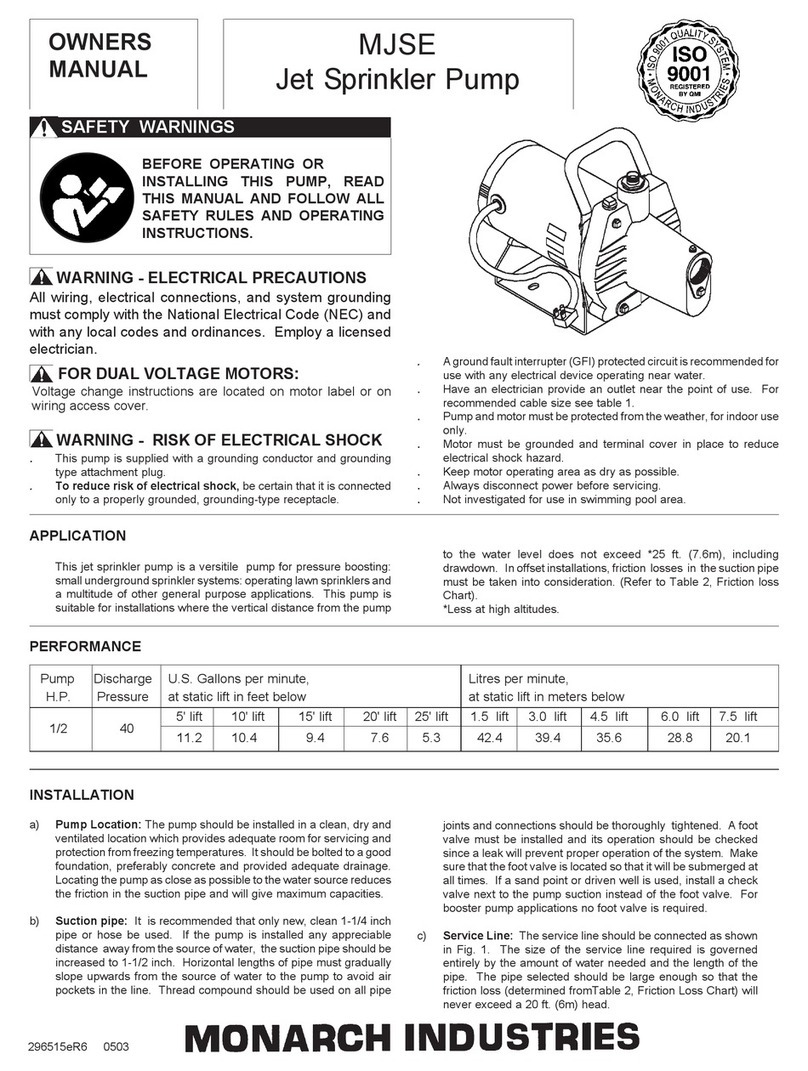
2
To Check for Proper Rotation: Remove the motor end cover.
This exposes the motor shaft. If hookup is correct, the shaft will
rotate clockwise. If rotation is not clockwise, reverse any two leads
to the starter. The rotation will now be correct.
WARNING - RISK OF ELECTRICAL SHOCK
GROUNDING THE MOTOR: WIRING TO THIS PUMP MUST
BE INSTALLED AND MAINTAINED IN ACCORDANCE WITH
THE NATIONAL ELECTRICAL CODE OR YOUR LOCAL
ELECTRIC CODE. IF MORE INFORMATION IS NEEDED,
CALL YOUR LOCAL LICENSED ELECTRICIAN OR YOUR
POWER COMPANY.
It is recommended that a permanent ground connection be made to
the unit using a conductor of appropriate size from a metal under-
ground water pipe or a grounded lead in the service panel. Do not
ground to a gas supply line. Do not connect to electric power supply
until unit is permanently grounded. Connect the ground wire to the
approved ground and then connect to the terminal provided.
longed period of time, the suction line should be led almost horizon-
tally to the pump. Non-toxic thread compound should be used on all
pipe joints and connections should be thoroughly tightened. A
strainer should be connected to the bottom end of the suction pipe
and it should be well submerged at all times.
WARNING - RISK OF ELECTRICAL SHOCK
•WIRING: Make sure the voltage and frequency of the power
supply agrees with that stamped on the motor nameplate. If
in doubt, check with the power company.
WARNING - ELECTRICAL PRECAUTIONS
All wiring, electrical connections, and system grounding must
comply with the National Electrical Code (NEC) and with any local
codes and ordinances. Employ a licensed electrician.
SINGLE PHASE: Determine incoming voltage to motor. Where
possible, use 230V. Connect wiring to terminal board located inside
motor end cover. Be sure voltage connections agree with wiring
diagram on motor nameplate.
THREE PHASE: Three Phase motors require magnetic starters,
and can run in either direction, depending on how they are con-
nected to the power supply.
WARNING: DO NOT RUN THE PUMP BEFORE PRIMING IT, SINCE THE SEAL AND IMPELLER COULD BE PERMANENTLY
DAMAGED.
OPERATION - PRIMING THE PUMP
PRIMING THE PUMP: A priming plug is provided in the top of the
casing to fill the pump with water. Once filled and the priming plug
replaced, the pump will prime. The priming time depends upon the
vertical and horizontal distance between the pump and the water
level. The pump should prime itself time after time as long as the
built-in check valve functions.
CAUTION: DO NOT run the pump before filling the pump
case with liquid, as it may damage the seal.
PRIMING UNDER PRESSURE: (Refer to Figure 1) Should it be
necessary to prime under pressure, place a check valve on the
discharge line of the pump and a pet cock or a ball type air bleeder
in place of the priming plug, or an air bleed line with a gate valve
connected to the discharge line. It will then be possible for the liquid
to remain in the discharge pipe and allow the pump to bleed off the
remaining air, thereby facilitating priming.
IMPELLER ROTATION: The impeller must rotate in a counter-
clockwise direction as seen facing the pump from the front of the
casing. In the event of wrong rotation for electric motor models,
refer to the instructions furnished with the motor. The rotation of
three phase motors can be changed by interchanging any two lead
wires.
STARTING THE PUMP: Never operate the pump dry as this may
damage the seal. If an exceptionally long suction line is used, the
water in the pump casing may become overheated or vapour
locked. Should this occur, replace the water in the casing with cold
water and continue priming.
DRAINING: Should the pump be subject to freezing temperatures,
it will be necessary to drain the pump completely. To drain, remove
the drain plug located at the bottom of the front face of the pump
casing and the priming plug and make sure that the drain
hole is not restricted. After all the water has been drained,
operating the pump for a few seconds will ensure that the impeller
is devoid of water (make sure that the suction line is also devoid
of water).
STORAGE OF PUMP: Drain liquid from pump to prevent freez-
ing. It is recommended that a good rust inhibitor be put in the
liquid end to prevent excessive corrosion. Be sure motor is kept
dry and covered. When restoring the use of the pump, replace all
plugs and make sure all connections are tightly sealed. After a
complete check is made, make the initial prime according to
directions under the section, Priming the Pump.
Figure 1
Gate Valve
(Min. 3/4")
Gate Valve
Pump
Air Bleed Line
Check Valve
Discharge
Strainer
Suction Line























